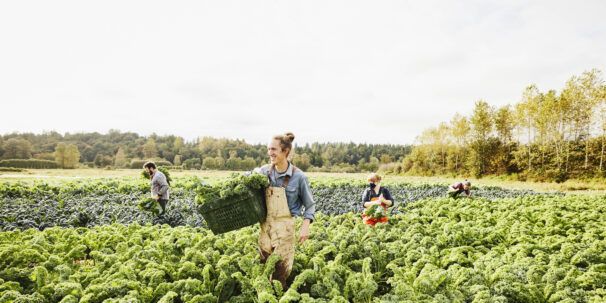How can technology help us to grow healthy, safe and sustainable food?
Learn how technology is used to grow healthy, safe and sustainable food in this post from EIT Food, Europe’s leading food innovation initiative. Written by Laura Elphick, EIT Food.

Today, our food production system faces many challenges. These include an increased demand for food, resulting from a growing global population, and the need for climate-smart solutions to reduce greenhouse gas emissions and biodiversity loss in farming. We have worked with EIT Food to explore some of the technologies that are helping food producers to grow food that is better for us and the planet.
What is sustainable food production and why is it important?
Our food production system needs new and optimised technologies to address sustainability challenges. These challenges can be grouped into the 3 pillars of sustainability that support people, planet and profit.
- Environmental sustainability – food production needs technologies that help to mitigate climate change, use fewer finite resources and help to minimise waste.
- Social sustainability – food production should guarantee access to food. Alongside this, it should also improve people’s welfare and not exploit workers.
- Economic sustainability – food production should be profitable for all actors in the food chain, while also meeting the needs of the present generation without compromising the ability of future generations to meet their own needs.
Sustainable food is a growing area of interest as research shows that more than one-third of global greenhouse gas emissions can be attributed to the way we produce, process and package food (United Nations, 2021). This is particularly alarming as we need to produce 60 percent more food than we do today (World Resources Institute, 2018) to be able to feed 2 billion additional people by 2050.
As a result, food producers are under pressure to grow more food in a sustainable way. For example, an EIT Food study of 20,000 consumers across 18 European countries found that three-quarters of consumers are concerned about the environmental impact of the food system, with only a third believing that their food is sustainable, (EIT Food, 2021). Therefore, increasingly, consumers are demanding food that is produced sustainably.
Benefits of sustainable food production
Producing food using sustainable methods can have positive implications for both people and planet. Technological solutions that are used in sustainable food production address issues such as:
- Increased traceability
- Improved animal welfare
- Increased efficiency
- Increased yield
- Reduction in greenhouse gas emissions
- Reduction in food waste
However, implementing sustainable food production methods can be expensive and often involve high up-front costs.
Not only that, even when a consumer recognises that a food product has been produced sustainably, it does not necessarily lead to the product being purchased. This is because sustainability is often overruled by factors such as price and convenience when consumers decide which food product to purchase (EIT Food, 2021).
However, producing food that is sustainable is increasingly important and food producers themselves can benefit from adopting technological solutions. This is because new technologies often achieve greater efficiency and profitability than outdated and labour-intensive approaches to producing food.






How can we use technology to help produce sustainable food?
Technology can be used throughout the food supply chain to produce safe and sustainable food for us to eat. In farming, precision agriculture makes use of advanced technologies for sensing, data analysis and automation. Examples include:
- Soil sensors. These allow farmers to precisely measure the nutrient composition of their soil. This helps farmers to plant certain crops where the soil is most beneficial and add exactly the right amount of additional nutrients required, reducing the need for excessive fertiliser use.
- Robotic seeders. These are ultra-light robots that sow seeds with minimal soil compaction compared to heavy-duty tractors. Soil compaction can cause poor root growth which reduces water and nutrient intake for the plant.
- Drones. They create high-resolution images of farmland, allowing farmers to examine farmland in real-time. Drones are fast and efficient and can help to monitor crop health, flooding extent and weed patches. EIT Food has worked with Outfield, an agritech startup, that uses drones to help farmers to reduce food waste by monitoring crop yields. Watch the video here.
Learn more about how new technologies can offer farmers novel ways to boost the long-term health of their soils here.
Case studies: How has technology changed farming?
Agricultural technologies are helping farmers to address key challenges such as greenhouse gas emissions from livestock production and real-time monitoring of animal welfare. Explore the case studies below to learn more.
C-Neutral Farming Case Study
EIT Food’s C-Neutral Farming project, led by Queen’s University Belfast, is creating a technological solution with farmers and agri-food businesses to help mitigate the environmental footprint from livestock production. To do this, they are developing a cloud-based carbon dashboard to assess whole-farm GHG emissions to enable farmers to make more sustainable decisions.
As said by Dr Shannon McLaughlin of Queen’s University Belfast who is working on the project:
“The C-Neutral Farming project will deliver a decision support tool to measure a farm’s net carbon balance and current carbon stocks. This easy-to-adopt tool will provide farmers with solutions to mitigate greenhouse gas (GHG) emissions to accelerate Europe’s journey to carbon-neutral livestock farming”.
Pig Tracker Case Study
EIT Food’s Pig Tracker project, led by the animal health company Zoetis, is transforming pork production. The project uses integrated state-of-the-art video cameras to monitor individual pigs from birth to the abattoir, providing information about the conditions in which the pigs are reared. This enables farmers to monitor the health and well-being of pigs in real-time to support the rearing of healthier animals and help farmers to manage their herds more efficiently.
The technology also provides traceable, transparent information about where pork comes from, to improve trust and support decision-making by consumers who are interested in where their food comes from and conscious of the conditions it is reared in.
Sustainable food technologies from start-ups
Despite the challenges faced by food producers to grow higher volumes of food sustainably, start-ups in the agri-food space are creating new solutions to address these challenges. Discover some of these start-ups below.
- Deep Planet. They’ve created a predictive crop analytic platform that combines machine learning, satellite imagery, and agricultural data to help supply chain companies and farmers to make better decisions. They help to predict soil moisture, soil nitrogen and crop yield.
- Thor Ice. This start-up has developed a patented cooling technology called the IceGun® to kill harmful bacteria on poultry meat, without using any chemicals or pharmaceuticals. Thor Ice machines are designed for eco-friendly refrigerants and can deliver savings in water and energy.
“Our ultimate goal is to make food safer and to prevent any unnecessary waste. Our technology is the only solution to major bacteria and cooling challenges the poultry industry is currently facing.” – Thorsteinn I. Viglundsson, CEO of Thor Ice
Listen to the CEO of Thor Ice, Thorsteinn Víglundsson, on the EIT Food Fight podcast here.
Deep Planet and Thor Ice are part of EIT Food’s start-up community. Explore more start-ups here.
What does the future hold for sustainable food technology?
Our food system has faced many challenges in recent years, such as Covid-19 impacting food supply and food security, extreme weather events destroying harvests and migration laws impacting the availability of seasonal workers on farms and in factories. We need solutions to address these challenges as well as others that will arise. To future-proof our food system we need the following to happen.
We need innovative technologies
Technologies must be innovative because they need to solve a particular problem within the food production system. Innovation should connect farmers, researchers and industry together to be able to develop solutions that make modern food production more sustainable, resilient, and productive.
We need technologies to be adopted
It is not just important for technologies to be created; we need technologies to be adopted throughout the food supply chain. Food producers need to have easy access to technologies. They also need to learn the skills required to operate them effectively and to be able to reap the benefits, such as increased efficiency and profitability.
We need technology to work in harmony with people and planet
We need to ensure technology does not replace labour altogether. In food production, technologies can be used to save time and protect employees from doing dangerous tasks themselves. Technology solutions should minimise the negative impact on the environment and be able to do something that humans cannot do easily, or at all.
Final thoughts
Food production technology can help to address some of the major problems that our food system faces today, particularly around growing more food in an efficient and sustainable way. Nevertheless, it’s important to remember that developing new technologies alone isn’t enough, as we need technologies to be both accessible and easy to use for food producers.
Learn more about food sustainability and technology
EIT Food offers a range of online courses to develop your knowledge and skills about this topic. Explore these courses below:
- Explore how farmers produce food sustainably
- Sustainable food production in a changing environment
- Innovation in arable farming: technologies for sustainable farming systems
- Improving food production with agricultural technology and plant biotechnology
- Revolutionising the food supply chain with technology
- How Food is Made: Understanding Food Processing Technologies










